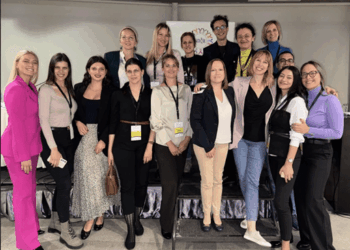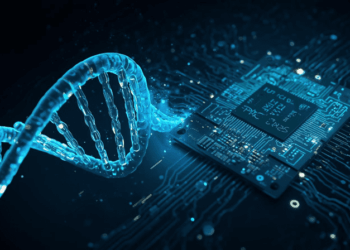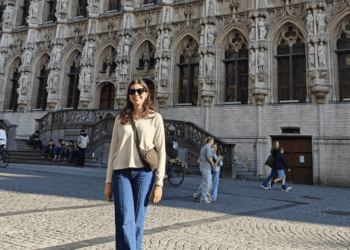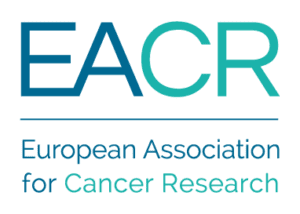Jessica Taylor is a Postdoctoral Fellow at the CRUK Cambridge Institute at the University of Cambridge, UK who received an EACR Travel Fellowship to visit and work at the Memorial Sloan Kettering Cancer Center in the US between October and December 2024.
The EACR, with support from Worldwide Cancer Research, provides Travel Fellowships of up to €3,500 to enable early-career cancer researchers to gain new skills through a short-term visit to a lab or research group in another country.
You can read about other Travel Fellows and their experiences here.
 Name: Jessica Taylor
Name: Jessica Taylor
Job title: Postdoctoral Fellow
Home institute: CRUK Cambridge Institute at the University of Cambridge, UK
Host institute:Memorial Sloan Kettering Cancer Center, US
Dates of visit: October – December 2024
Research: Many children survive brain tumours after treatment with combination surgery, radiotherapy and chemotherapy, but sadly they don’t always thrive. I work on a specific subtype of brain cancer in children called WNT-Medulloblastoma, which has a very high survival rate. Surgery to remove this tumour is risky as it occurs in the back of the brain and the way that it grows can cause it to bleed a lot. I am developing the first diagnostic imaging agent that will identify a specific molecular subtype of brain tumour before surgery, quickly putting these children on a low-intervention therapeutic pathway.
Why did you choose to apply for an EACR Travel Fellowship?
I am an EACR member, and I happened to see an email about the Fellowship whilst I was looking for some extra funding to ensure I could maximise the benefit from my planned trip as part of my Research Fellowship.
Why did you choose the host lab?
Jason Lewis is a global leader in radiochemistry and theranostics. Our diagnostic probe for WNT-medulloblastoma will be linked to a radiometal so that we can use PET scanning to diagnose patients, and the Lewis lab conjugates these types of antibodies day-in, day-out. We hope to eventually pair our diagnostic imaging agent with a drug that will specifically target tumour cells, and even further reduce the harm that current therapeutics cause these children – this type of dual therapy is known as “theranostics” and the Lewis lab was the perfect place to learn all about the complexities of this approach.
Can you summarise in the research you did or what you learned on your visit?
During my visit I learned how to purify and chelate antibodies with a high recovery yield – important as antibodies are very expensive. I learned how to carry out experiments that I hadn’t had much experience with previously, such as thin-layer chromatography, binding and biodistribution assays. I also had the opportunity to carry out a small project that demonstrated each important step from antibody to in vivo PET-imaging, that generated proof-of-principle data for the work that I will be carrying out back in the UK. Most importantly, I was able to work side-by-side with lab members who were using radiometals every day for in vitro and in vivo studies. This gave me the opportunity to understand how to work safely and efficiently with these valuable, potentially dangerous, and complex isotopes.
“Working in a fast-paced, new environment, with nothing to do but learn was truly wonderful and has reignited my passion for science”
Describe a ‘typical day’ on your visit.
A typical day would begin very early for me, trying to make sure I was available to my home lab in my role as the Project Licence Holder for all the in vivo research in our lab involving brain tumours. I would ensure that I got all these responsibilities out of the way first thing, then head to my local yoga studio in Queens for a quick morning flow (and shower), then I’d hop on to an N train to Manhattan.
Once I arrived at the lab on the Upper East Side, I settled down in the break area with a coffee to plan my experiments for the day. Working in a radiochemistry lab involves a lot of math(s), and although my background is in biochemistry, my current role is much more biology focussed, so the switch was hard for me. Having this extra time in the morning to really focus on the maths and understand the calculations before heading into the lab was extremely valuable.
Radiometals, by their nature, decay over time. This meant that our experiments had to be planned around when we would get the radioisotopes delivered into the lab and what we could get done in the window of time we had after that. Dr Shaniqua Haynes, the postdoc I worked with during my visit, was working on her own project whilst also helping me design and plan my own research, so I was lucky enough to be able to shadow her experimental work most days. If there was no 89-Zirconium delivery that day, we would chelate antibodies, purify and quantify them, passage cells or go through how to use the imaging software using previous PET data.
When there was 89-Zirconium delivered, it was all hands-on-deck. Measuring the activity of the stock and ensuring our calculations were correct and our chelated antibodies were at the right pH for conjugation. Another tricky thing to get my head around was that unit for measuring the activity of a radioactive material in the US is Curie (Ci), whereas in Europe we use becquerels (Bq) – One Ci) is equal to 3.7 × 1010 Bq, so not an easy conversion to do on the fly. Depending on our plans for the later half of the week, we would either conjugate enough antibody for our in vitro experiments, or we would prepare syringes for in vivo injection. Once the mice were given their doses of radioactive antibodies by the wonderful technical staff, we would then image them on the PET scanner daily to measure peak activity and biodistribution in non-target organs.
At the end of an in vivo study, taking samples from each mouse would take precedent. Following an early imaging session, we would spend the rest of the day taking samples for terminal biodistribution and histology. We would also freeze samples to analyse antibody penetration into the tumour using autoradiography, a cool technique that measures the activity in frozen histological sections.
On Friday mornings, we also had lab meetings where I got a chance to hear about the amazing work done by other members of the lab, or present my own work, with a side of true NYC pizza.
 What were you able to do that you could not have achieved in your home lab?
What were you able to do that you could not have achieved in your home lab?
Although we have expertise in PET/SPECT and molecular imaging at the CRUK Cambridge Institute, the expertise to work with specific radiometals such as 89-Zirconium is not available. Equally, the demand for these radioisotopes is not there yet, so regular deliveries just to pilot small experiments are not feasible at this point.
Did you take part in any interesting local activities?
New York is obviously one of the most dynamic and diverse cities in the world and living in such a cultural hub for three months was an amazing opportunity. I was also in New York for the trifecta of important “holidays” – Halloween, Thanksgiving and Christmas – New Yorkers take their holidays seriously and the decorations, even just outside residential homes, were unbelievable.
I took part in the Halloween parade with members of my lab, as well as being lucky enough to be able to visit my in-laws for thanksgiving. They are New York natives but have retired to Nevada, and it usually too expensive for us to fly there during peak holidays.
What was a personal highlight of your trip?
There were so many highlights, too many to name, but for me this trip was about resetting and learning new skills. Postdoc life can be hard, there’s a lot of experimental failures, delays and countless other problems that arise daily. Sometimes it feels like you’re not doing the job you originally signed up for, and you spend more time on admin than at the bench. Working in a fast-paced, new environment, with nothing to do but learn was truly wonderful and has reignited my passion for science.
 Was there anything you particularly liked about the host institution?
Was there anything you particularly liked about the host institution?
The central location of the host institute in Manhattan was particularly appealing, Cambridge is beautiful, but it lacks the bustle of a major city (and definitely lacks the food options). The general layout of the institution was comfortingly similar to the CRUK CI, just on a much, much bigger scale.
Did you have a personal mentor or anyone who particularly helped you?
Dr Shaniqua Haynes was with me almost every day, making sure I knew what I was doing, correcting my maths, teaching me new techniques and generally just being an all-round star. I hopefully managed to impart some of my biology-based wisdom in return, but she is always welcome in Cambridge if she wants to learn more!
How has the trip inspired you in your research?
I think the trip has really inspired me to get back to basics with my work, spend more time at the bench and prioritise my science. We will continue to collaborate with the Lewis lab, and are excited to progress the project going forward.
Want to find out more?
If you are interested in applying for the Travel Fellowship scheme, please click here for more information: EACR Travel Fellowships.



 What were you able to do that you could not have achieved in your home lab?
What were you able to do that you could not have achieved in your home lab? Was there anything you particularly liked about the host institution?
Was there anything you particularly liked about the host institution?




